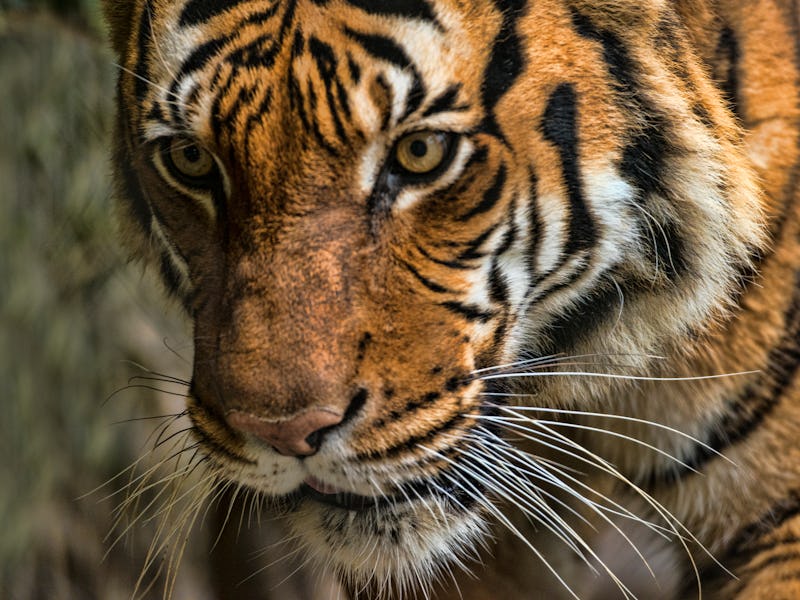Why is the Malayan tiger endangered? Two reasons the big cat is in trouble
"Every tiger remaining in the wild is precious.”

There are few animals more majestic than the tiger. But as beautiful as these big cats are, so are they threatened by extinction.
The International Union for Conservation of Nature Red List, a catalogue of critically endangered species across the globe, classifies all tigers as endangered. But the Malayan tiger is one of the rarest of all — and critically endangered.
Here's everything you need to know about these big cats and what efforts are ongoing to try and save them from extinction.
What is the Malayan Tiger?
The Malayan tiger is a critically endangered tiger subspecies that lives only in the tropical rainforests of Malaysia. To give it its scientific name, it is Pantheris tigris ssp. jacksoni.
It was discovered in 2004 after a series of genetics studies revealed the tigers in this part of Malaysia are diverse enough to be considered their own subspecies, according to a National Geographic report. Before being recognized as its own subspecies, it was known as the Indochinese tiger, according to the report.
Where is the Malayan Tiger from?
Malaysia is located on the southern most part of the Malay Peninsula in Southeast Asia, and is bordered on the north by Thailand. The Indonesian islands are to the south.
What makes the Malayan Tiger so special?
These tigers are particularly special because they are rare. Tiger numbers in general are dwindling, having lost 97 percent of their population in the last 100 years.
“What that means is that every tiger remaining in the wild is precious,” Peter Zahler, Vice President of Conservation Initiatives at the Woodland Park Zoo in Seattle, tells Inverse.
Malayan tigers are widely considered to be one of nine original subspecies. Three of the subspecies are already extinct, and a fourth, the South China tiger, is likely extinct in the wild. Tiger genetics and subspecies designations are still actively investigated and debated, so it’s possible that the categorization of the Malayan tiger will change. But regardless of how scientists characterize it, this group of tigers is disappearing quickly.
Malayan Tiger stock photo
How many Malayan tigers are in the wild?
According to John Goodrich, Chief Scientist and Tiger Program Director for Panthera, the global wild cat conservation organization, there are around 150 Malayan tigers left in the wild. The IUCN Red List says there are between 80 and 120 breeding adults left.
That number is likely declining, the IUCN warns.
How many Malayan tigers are in captivity?
There are roughly 70-80 tigers in captivity in the United States and abroad, Zahler estimates, although it is hard to know for sure.
What has caused their numbers to dwindle? Are humans to blame?
Yes, humans are to blame. The two major causes of Malayan tiger decline are poaching and forest degradation.
Malayan tigers are illegally hunted for the traditional Chinese medicine market, Goodrich tells Inverse. Poachers come mostly from outside of Malaysia and set up encampments deep in the rainforest where they hunt the tigers with snares.
Massive conversion of Malayan rainforests to palm oil plantations has also significantly reduced Malayan tiger habitat, leading to their decline.
“There are just very few wild areas left that can support tigers,” Zahler says.
Malayan tiger at Woodland Park Zoo
Any conservation efforts ongoing? Are they working?
Panthera and the Woodland Park Zoo have worked on a variety of conservation initiatives. These include securing tiger habitat and disrupting poaching and the illegal wildlife trade. They coordinate their efforts with local law enforcement, Malaysia’s Department of Wildlife and National Parks, and other conservation groups.
Together, these organizations set up patrols to detect poaching camps and offer support and education to assist with the prosecution of wildlife crimes.
To protect tiger habitat, they also helped establish Kenyir State Park in Malaysia, and are hoping to continue expanding this park to encompass additional tiger habitat.
“Oil palm plantations have exploded in the region, quickly taking over available landscapes, so protecting these last wild forests is critically important for tigers and other wildlife,” Zahler says.
Goodrich also emphasizes the importance of tackling the wildlife trade supply chain, including traders and buyers, and says law enforcement can only be part of the solution.
“You need to address it from social levels, economic levels, as well as addressing the crime itself,” Goodrich says.
Malayan tigers also receiving aid from an unexpected source — the coronavirus. Because Malayan tiger poachers tend to come from other nations, coronavirus lockdowns are actually giving the population a little bit of a break, Goodrich says. Coincidently, it was a captive Malayan tiger that was first diagnosed with the coronavirus during a big cat outbreak at the Bronx Zoo in New York.
Tigers populations increase slowly, as mature adults only produce a litter of cubs every two years. It can take a while to see the impacts of conservation programs. However, Zahler says they’ve been able to document the presence of tigers with cubs in project areas where they didn’t used to be able to detect tigers.
“At the specific site where we're working, [the population is] stable, but we’re definitely not out of the woods,” Goodrich says. “We are very, very concerned about Malaysia.”
This article was originally published on